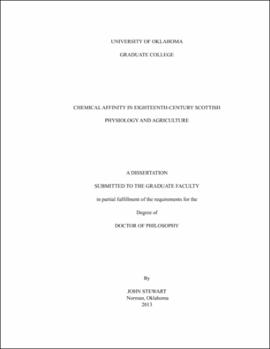| dc.contributor.advisor | Barker, Peter | |
| dc.creator | Stewart, John | |
| dc.date.accessioned | 2019-04-27T21:34:12Z | |
| dc.date.available | 2019-04-27T21:34:12Z | |
| dc.date.issued | 2013 | |
| dc.identifier | 99308547802042 | |
| dc.identifier.uri | https://hdl.handle.net/11244/319038 | |
| dc.description.abstract | The standard historiography of eighteenth-century chemistry focuses on the chemical revolution. French chemists, most notably Lavoisier, replaced the phlogiston theory of combustion with a new one based on oxygen and modernized the chemical nomenclature. This history has largely been treated as internal to the history of chemistry. | |
| dc.description.abstract | My dissertation decenters combustion and the French contribution by continuing modern work by Mi Gyung Kim (2003) and Georgette Taylor (2006) that locates elective attraction as the fundamental chemical theory in the second half of the eighteenth century. Also referred to as chemical affinity, this was an empirical theory that recorded the combining preferences of simples and compounds in order to understand and predict reactions. The development and demise of this theory extends well beyond the boundaries of chemistry as a technical subject. | |
| dc.description.abstract | I establish the existence of an important affinity school in Scotland centered in the work of William Cullen (1710-1790), Joseph Black (1728-1799), and their students. These lecturers applied affinity not only to inorganic chemistry but also to medicine, including respiration, and the treatment of syphilis and smallpox. The application of affinity theory in the medically important study of mineral waters, led to the advancement of chemical analysis techniques, but also to serious experimental and theoretical problems for the affinity theory in the work of John Murray from 1815 to 1817. | |
| dc.description.abstract | Well before this, however, Scottish chemists had applied affinity theory to agriculture. The Scottish Improvement movement of the eighteenth century focused the advancement of agricultural yields. Led by the third Duke of Argyll and Lord Kames, the Scottish great landowners attempted to rationalize agriculture through chemistry, and in turn advanced the careers of important affinity chemists like Cullen and Black. Commercial and industrial applications of affinity theory included the production of manures, the production and sale of artificial mineral waters, and the preparation of soda and alkaline salts for bleaching, a key process in the textile industry. As a consequence, the history of affinity chemistry cannot be understood without reference to the political, social, and economic issues that come to the fore in this dissertation. | |
| dc.format.extent | 197 pages | |
| dc.format.medium | application.pdf | |
| dc.language | en_US | |
| dc.relation.requires | Adobe Acrobat Reader | |
| dc.subject | Chemistry--Scotland | |
| dc.subject | Chemical affinity | |
| dc.subject | Pharmaceutical chemistry--Scotland | |
| dc.subject | Agricultural chemistry--Scotland | |
| dc.title | Chemical Affinity in Eighteenth-Century Scottish Physiology and Agriculture | |
| dc.type | text | |
| dc.type | document | |
| dc.thesis.degree | Ph.D. | |
| ou.group | College of Arts and Sciences::Department of History of Science | |
